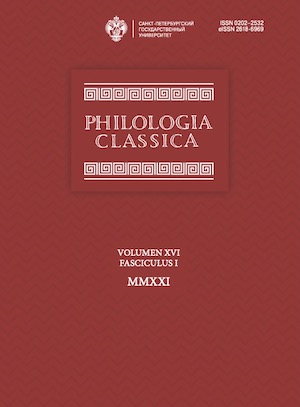“The Messengers are Called Sangandai”: the Greek σαγγάνδης and its Relationship to ἀσγάνδης/ ἀστάνδης
DOI:
https://doi.org/10.21638/spbu20.2021.104Аннотация
This article examines the Greek noun σαγγάνδης ‘messenger’ which is attested in two lexica, dated to the Roman or early Byzantine periods: the Cambridge Rhetorical Lexicon by an anonymous author and Difficult Words in the Attic Orators by Claudius Casilo. In both works, σαγγάνδης appears together with three words of likely Iranian provenance: ὀροσάγγης ‘benefactor of the Persian king; bodyguard’, παρασάγγης ‘parasang; messenger’ and ἄγγαρος ‘messenger, courier; workman, labourer’. The word σαγγάνδης is analysed in comparison with ἀσγάνδης/ ἀστάνδης ‘messenger’ occurring for the first time in Plutarch’s works and closely linked to the Achaemenid administration. According to the hypothesis put forward in the present paper, both σαγγάνδης and σγάνδης (with its secondary variant στάνδης) are connected to Manichaean Middle Persian/Parthian ižgand ‘messenger’, Sogdian (a)žγand/(ɔ) žγand/ž(i)γant ‘id.’, Jewish Aramaic ʾîzgaddā ‘id.’, Syriac izgandā/izgaddā ‘id.’, Mandaic ašganda ‘helper, assistant, servant; the Messenger’, and go back to Old Persian *zganda- or to early Middle Persian/early Parthian *žgand- (or *zgand-) with the original meaning ‘mounted messenger’. The reconstructed noun is derived from the Proto-Iranian root *zga(n)d- ‘to go on, gallop, mount’, attested in Avestan (Younger Avestan zgaδ(/θ)- ‘to go on horseback, gallop’) and in some Middle and Modern Iranian languages. The original form of the loanword in Greek was probably *σγάνδης which then underwent certain transformations.
Ключевые слова:
etymology, foreign words in Greek, Iranian loanwords, Greek lexicography
Скачивания
Библиографические ссылки
Загрузки
Опубликован
Как цитировать
Выпуск
Раздел
Лицензия
Статьи журнала «Philologia Classica» находятся в открытом доступе и распространяются в соответствии с условиями Лицензионного Договора с Санкт-Петербургским государственным университетом, который бесплатно предоставляет авторам неограниченное распространение и самостоятельное архивирование.






